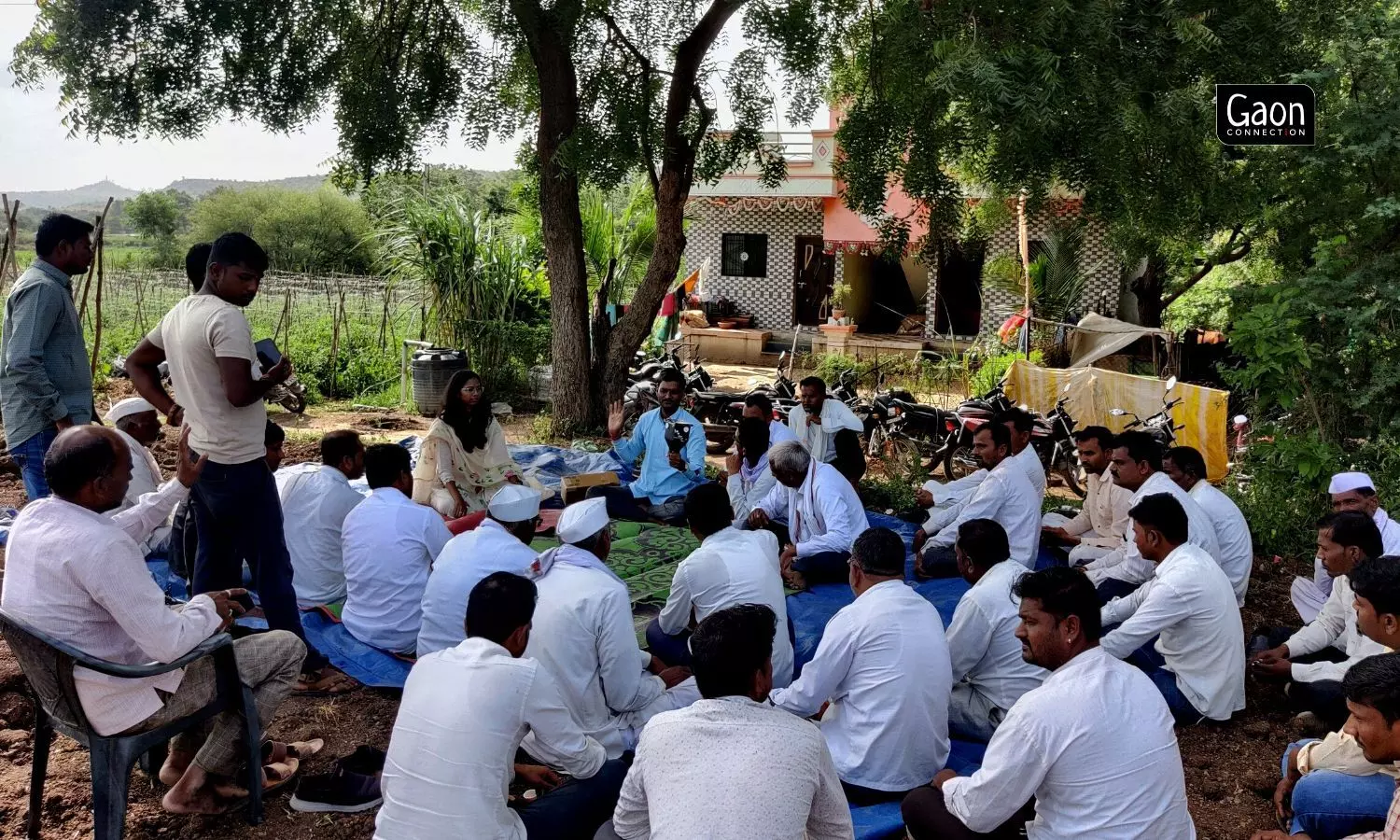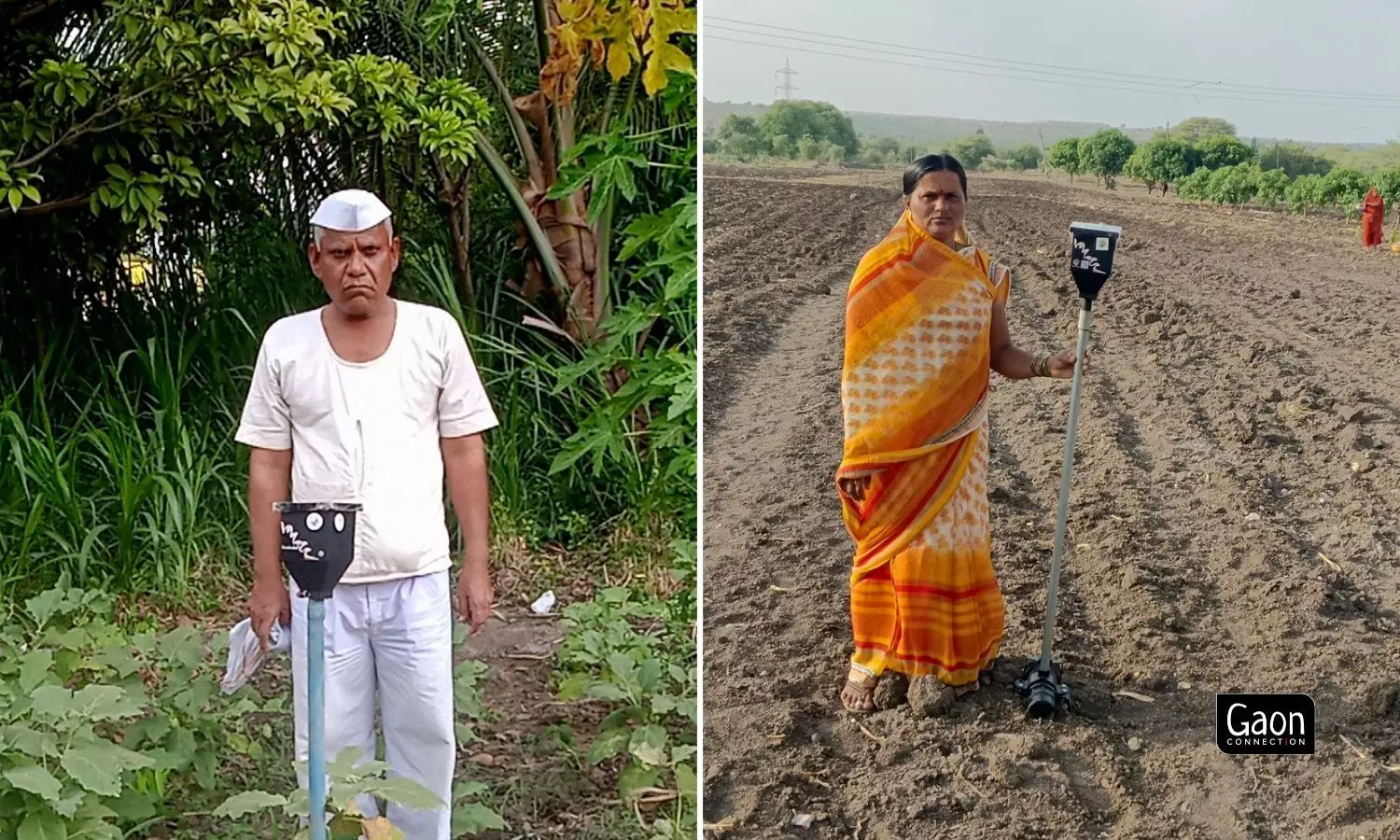When Malan Sambhaji Raut got a borewell installed in 2016, she thought that would mark the beginning of a healthy yield of crops on her 2.5 acres of land in Latur — a drought-prone district in Maharashtra.
It did, as she now was able to grow as many as 25 varieties of vegetables including brinjal, ladies finger and several greens on one acre, and pomegranate, sitaphal (custard apple) and jamun (black plum), on the remaining 1.5 acres (1 acre = 0.4 hectare).
But her joy was short lived as she lost them all to rampaging deer and wild boars that invaded her fields in the cover of darkness and damaged her crops. The 36-year-old farmer from Nagarsora village in Aura taluka in Latur was heartbroken.
“I invested around Rs 30,000 in my fields and lost all of it,” she told Gaon Connection.
Help came from an unexpected quarter. In April 2019, Katidhan, a Bengaluru-based organisation (it works on finding tech solutions to reduce losses in the agriculture sector due to wildlife attacks) came up with a unique portable device of the size of a piggy bank(10.5×10.5×22 cm) to address human-wildlife conflict, which brought relief to Raut.

The device has a single solar panel varying from 3 watt to 6 watt, fitted to a lithium-ion battery and four LED lights that blink and create random patterns across the field.
Parabraksh is a solar powered autonomous flash light(which switches on at night and goes off during the day) developed by Katidhan, which it gave the hapless farmer in Latur free of cost for a trial. Parabraksh uses solar-powered technology to generate light flashes to scare animals away from the fields, without harming them. Raut mounted the flashlight on an iron rod and placed it at a strategic part of her field to deter wild animals. And it worked.
The device has a single solar panel varying from 3 watt to 6 watt, fitted to a lithium-ion battery and four LED lights that blink and create random patterns across the field.
“The flashing light that is visible up to 500 metres away, keeps the wild boar, nilgai, bison, elephants, tigers, and leopards away,” Pranjali, the outreach official from Katidhan told Gaon Connection. As the flashlight runs on solar energy it is a solution in remote villages where electric supply may be erratic.
The flashlight has been about 90 per cent effective for Raut in the two years she has used it on her field. It has kept the wild animals at bay, saved her crops and enabled her to make a profit of nearly Rs 90,000 a year by selling her vegetable produce, said Raut.
Also Read: A solar irrigation pumpset that fits into a jhola is helping marginal farmers
“I had moved to a jhopdi [hut] on my land to stand watch at night with my dog for company. I no longer have to stay awake all night, braving mosquitoes and fearing snakes and scorpions,” said the farmer, who has since been sleeping at peace in her own home two kilometres away from her land.
Katidhan has installed around 1,000 units of Parabraksh in 12 states — Karnataka, Jharkhand, Maharashtra, Himachal Pradesh, Telangana, Andhra Pradesh, Tamil Nadu, Kerala, Rajasthan, Uttarakhand, Assam, Odisha. More than 1,500 farmers are using it, said the outreach official Pranjali.
Over 1,200 kilometres south of Raut’s village in Maharashtra, K Rajesh from Theni district in Tamil Nadu was driven to despair by elephants and wild boars. He had left his 20 acres of land fallow for over five years between 2016 and 2021 after the wild animals had uprooted coconut trees, destroyed banana plantations and trampled vegetables on his land.
Rajesh’s village Kullappagoundanpatti is surrounded by Murugamalai Reserved Forest on three sides. To keep the wild animals away, the farmer had tried erecting solar fencing and digging trenches, but all in vain.

Katidhan has installed around 1,000 units of Parabraksh in 12 states — Karnataka, Jharkhand, Maharashtra, Himachal Pradesh, Telangana, Andhra Pradesh, Tamil Nadu, Kerala, Rajasthan, Uttarakhand, Assam, Odisha.
“The solar fencing short circuits if creepers grow over it, and the trenches work only briefly before the elephants trample mud into them and create a path for themselves,” Rajesh told Gaon Connection.
“I lost almost 500 coconut trees to elephants. Wild boars dug up acres of banana saplings. I don’t even know how much money I lost in these past years,” he complained.
Rajesh finally chose to try out Parabraksh in October 2022. Ever since, his fields haven’t been attacked yet.
The 69-year-old farmer used the flashlight on 55 cents [0.5 acre] of his land and said he would procure more soon. Unlike Raut, Rajesh paid Rs 10,000 for the solar light and it was delivered to him in three days.
Talking about the efficacy of using light-based methods to address human-wildlife conflict, Kartick Satyanarayan, Co-founder and CEO, Wildlife SOS, said: “Nocturnal animals move into agricultural fields during nightfall, which is when crop raiding occurs. The presence of light, human beings or any movement, can certainly deter animals from entering fields. For this any solar light can cause deterrence. But the presence of light in places like beaches where turtles come to nest, can have a very negative impact on the nesting behaviour of turtles.”
In the wild elephant project being run in Chhattisgarh, Wildlife SOS, a conservation non-profit organisation, observed the villagers were able to deter elephants from entering fields by using light and sound.
“When elephants, leopards and other wild animals see the presence of light or sound, they avoid heading in that direction,” he told Gaon Connection.
Also Read: ‘Powering Livelihoods’ through Renewables is the Talk of the Town
According to Satyanarayan, the Parabraksh technology is very similar to any solar light that is being used commonly in agricultural applications and is likely to work just as other light deterrents work.
However, he emphasised that it will require more research to confirm if wild animals become habituated and become indifferent to the presence of that light after some time.
Meanwhile, the cost of the device is a matter of concern for small and marginal farmers. As far as Rajesh knows, he is the only farmer to have installed Parabraksh on his land in the area in Theni. “The light is too costly for small and marginal farmers,” he said.
Raut from Latur said that other farmers were interested in trying out the flashlight. She is director of Swayam Sakhi Shetmal Farmer Producer Company in Nagarsora village, and works closely with 1,000 small and marginal farmers.

The solar flashlight is emerging as a clean energy solution for farmers who lose their crops to wild boars, elephants and deer but is unaffordable for small and marginal farmers.
“They would be happy to try out the flashlight, but they cannot afford to buy it,” she said. They also worry about the repair and servicing the flashlight may require.
‘Who does one approach if this stops working?’, ‘How quickly will it be replaced?’, ‘Will the company send someone to service and repair it, or does one have to transport it to the company?’ are some of the common questions they ask, Raut said. “My solar panel is unserviceable since April this year and I have not been able to get it fixed,” she pointed out.
She advocated that the government should step in to subsidise Parabraksh as a solution for farmers.
The solar flashlight has a one-year service warranty. Pranjali from Katidhan said that she isn’t yet aware about Raut’s damaged solar panels and will get in touch with her to resolve it.
“We replace the batteries and panels if they have any damages within one year, and direct the farmers to nearby shops to get their components replaced in case they have surpassed the warranty period,” she informed Gaon Connection.
The company acknowledges that buying the flashlight is a challenge for small farmers. “The company has not been able to reduce the cost of Parabraksh. If the demand increases, and the production increases too, then the price will come down,” said the company official Pranjali.


















